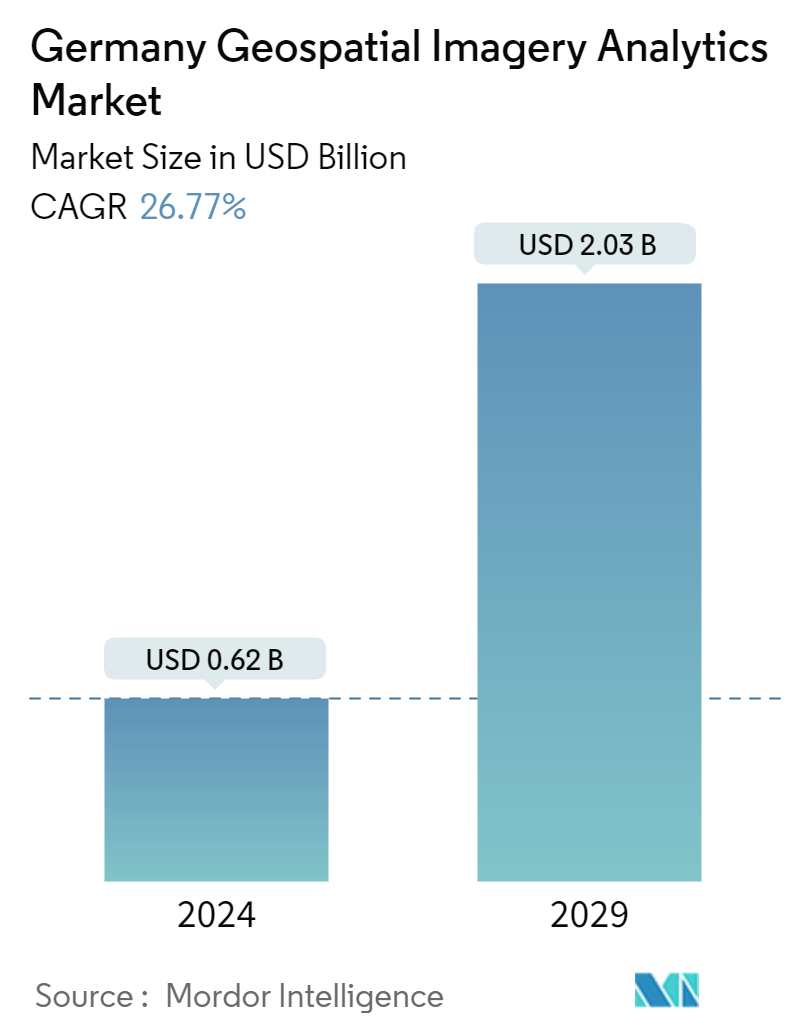Market Size of Germany Geospatial Imagery Analytics Industry

| Study Period | 2018 - 2028 |
| Base Year For Estimation | 2023 |
| Market Size (2024) | USD 0.62 Billion |
| Market Size (2029) | USD 2.03 Billion |
| CAGR (2024 - 2029) | 26.77 % |
| Market Concentration | Medium |
Major Players
*Disclaimer: Major Players sorted in no particular order |
Germany Geospatial Imagery Analytics Market Analysis
The Germany Geospatial Imagery Analytics Market size is estimated at USD 0.62 billion in 2024, and is expected to reach USD 2.03 billion by 2029, growing at a CAGR of 26.77% during the forecast period (2024-2029).
- The growing urban population in Germany and the use of data analytics in various industries are driving market growth. Applying geospatial imagery analytics for climate assessment, urban planning, and disaster response also supports this growth. Additionally, linking numerical and geo-referenced statistics in spatial analysis can reveal relationships and phenomena that traditional analyses might miss. This shows the growth potential of geospatial imagery analytics in Germany.
- The German government is promoting smart cities and regions with approximately USD 882.11 million fund. The Model Projects Smart Cities supports 73 projects, creating best practices for 11,000 German municipalities. This shows the country's priority in developing urban planning and construction, which will fuel the demand for the market in the future due to the application of geospatial data analytics on resource planning and urban project development.
- Geospatial analytics uses maps to understand spatial contexts and show information through visual patterns and images. It also improves situational awareness and emergency response. By using real-time spatial data and predictive models, emergency responders can identify high-risk areas, coordinate operations, and allocate resources efficiently during natural disasters, humanitarian crises, or public health emergencies. This supports market growth in Germany, aligning with the country's focus on environment monitoring during the forecast period.
- However, one of the primary challenges in geospatial imagery analysis lies in guaranteeing the data's high quality and accurate representation. Integrating data from diverse sources poses another constraint, given the variations in formats, scales, and projections. Additionally, geospatial data frequently contains sensitive information, including personal data, necessitating stringent protection under privacy laws and regulations.
- The COVID-19 pandemic positively impacted the adoption of geospatial imagery analytics solutions in Germany. This market's sustainability is mainly driven by the extensively increasing adoption of geospatial data analytics-based services by businesses to understand customer behavior and increase sales. Additionally, these solutions allowed users to map the different locations and other services on a dashboard, which aids in superior monitoring and surveillance for disease clusters or hotspot identification and comparing alternative strategies to prevent the spread of the diseases during the COVID-19 pandemic.

